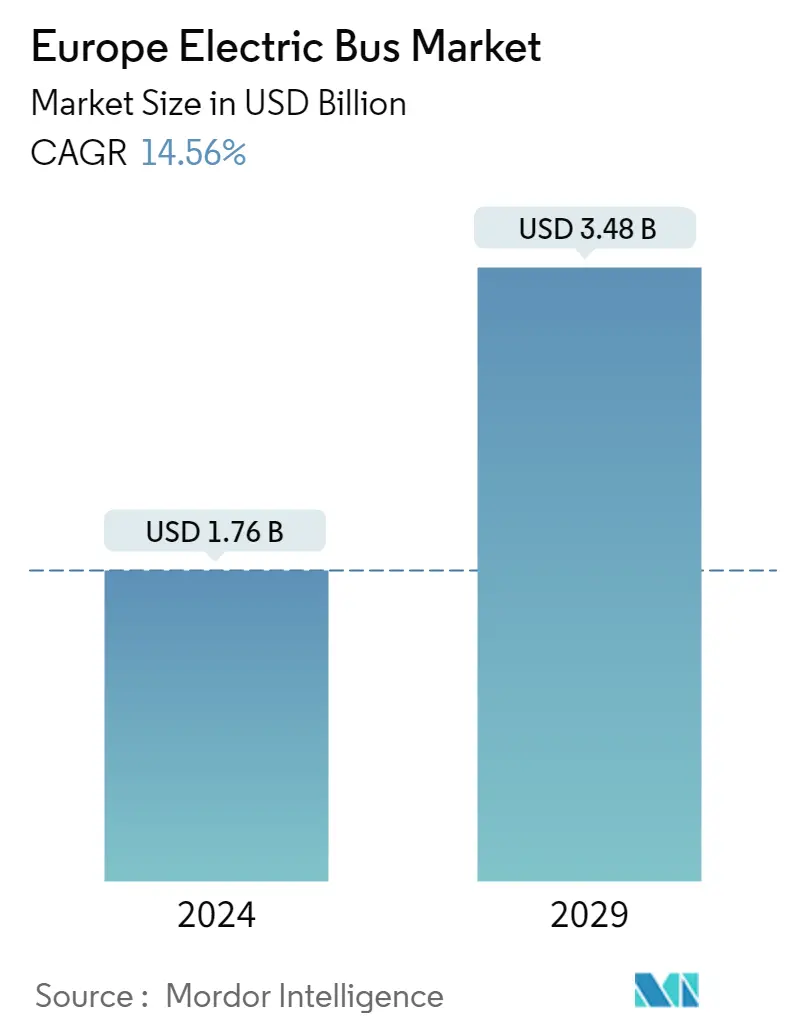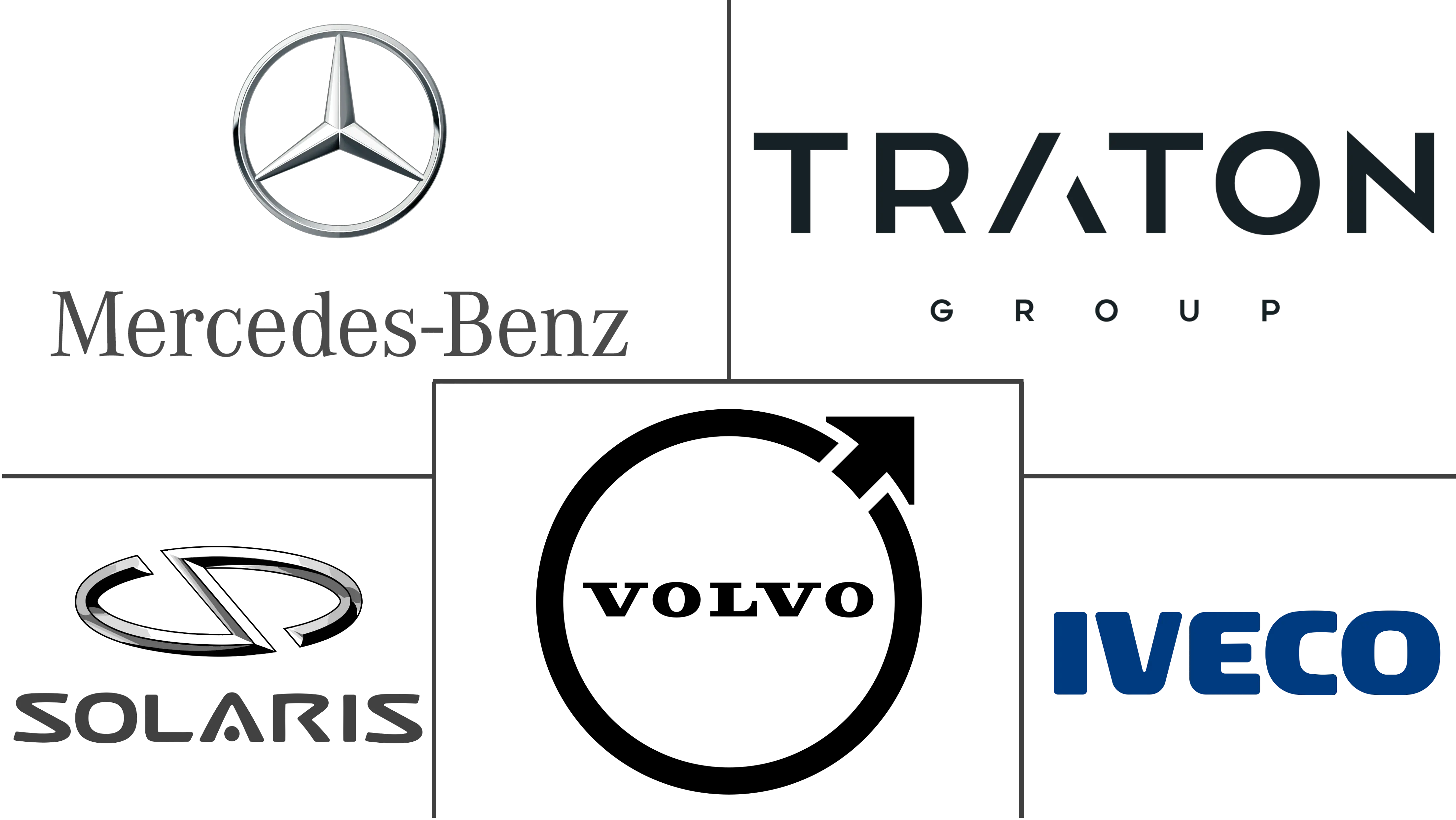Market Size of Europe Electric Bus Industry

| Study Period | 2019 - 2029 |
| Base Year For Estimation | 2023 |
| Market Size (2024) | USD 1.76 Billion |
| Market Size (2029) | USD 3.48 Billion |
| CAGR (2024 - 2029) | 14.56 % |
| Market Concentration | Medium |
Major Players
*Disclaimer: Major Players sorted in no particular order |
Europe Electric Bus Market Analysis
The Europe Electric Bus Market size is estimated at USD 1.76 billion in 2024, and is expected to reach USD 3.48 billion by 2029, growing at a CAGR of 14.56% during the forecast period (2024-2029).
- Clean technologies in public transportation are more and more needed in the current scenario to cope with air pollution in urban areas. The demand for electric buses in Europe has augmented dramatically over the last decade.
- The factors which are driving the Electric Bus (EB) demand in Europe are stringent emission regulations, high dependence on conventional or non-renewable fuels, strong environmental ethics, and the growing need to integrate renewables into a network. The penetration of charging infrastructure also plays an important role in market development.
- The electric bus market is growing significantly in Europe. However, there are a few challenges in the market, such as charging a large number of EBs is the potential impact on the grid and on the batteries, simultaneous charging of an EBs fleet could drive to a tremendous high power peak, oversizing of infrastructures, equipment, and grid supply subscription could generate extra costs.
- Major European Electric Bus markets include the United Kingdom, Netherlands, Norway, Luxembourg, and Poland. The United Kingdom and other Central European countries are upgrading their fleet with low or zero-emission buses and retrofitting the old buses with low-emission powertrains, which in turn is projected to intensify the growth of the electric bus market in Europe during the forecast period.
Europe Electric Bus Industry Segmentation
The European Electric Bus Market is segmented by Propulsion type (Battery Electric Bus, Plug-in Hybrid Electric Bus, and Fuel Cell Electric Bus), By battery type (Lithium-ion, Nickel-metal hydride battery (NiMH), and Others), By Consumer Type (Government and Fleet Operators), and by Country. The report offers the market size and forecasts in Value (USD billion) for all the above segments.
The Europe Electric Bus Market covers the latest electric bus demand trends, technological development, latest government policies, battery technologies, etc. It also covers the market share of major electric bus manufacturers across Europe.
| By Propulsion Type | |
| Battery Electric Bus | |
| Plug-in Hybrid Electric Bus | |
| Fuel Cell Electric Bus |
| By Battery Type | |
| Lithium-ion | |
| Nickel-Metal Hydride Battery (NiMH), | |
| Others |
| By Consumer Type | |
| Government | |
| Fleet Operators |
| By Country | |
| Germany | |
| United Kingdom | |
| France | |
| Italy | |
| Netherlands | |
| Norway | |
| Spain | |
| Poland | |
| Other Countries |
Europe Electric Bus Market Size Summary
The European electric bus market is experiencing significant growth, driven by the increasing need for clean technologies in public transportation to address urban air pollution. The demand for electric buses is fueled by stringent emission regulations, a strong commitment to environmental sustainability, and the integration of renewable energy sources into transportation networks. The expansion of charging infrastructure is also a crucial factor in the market's development. Major markets in Europe include the United Kingdom, Netherlands, Norway, Luxembourg, and Poland, where efforts are underway to upgrade fleets with low or zero-emission buses. The transition to electric buses is supported by public transit operators and city governments, with a target for a substantial portion of urban bus fleets to be electrified by the end of the decade.
The market is characterized by the involvement of key players such as Solaris Bus & Coach, IVECO Bus, Traton Group, AB Volvo, and Mercedes-Benz Group AG, who are actively contributing to the production and deployment of electric and hydrogen-powered buses. Initiatives like the European Clean Bus Deployment Initiative and national strategies in countries like Germany and Belgium are promoting the adoption of zero-emission vehicles. The Netherlands has set ambitious targets for zero-emission public transport buses, while other countries are exploring hydrogen as a viable alternative. The market's growth is also supported by policies and investments aimed at achieving carbon neutrality in transportation, reflecting a broader trend towards electrification and sustainable mobility solutions across Europe.
Europe Electric Bus Market Size - Table of Contents
-
1. MARKET DYNAMICS
-
1.1 Market Drivers
-
1.2 Market Restraints
-
1.3 Porter's Five Forces Analysis
-
1.3.1 Threat of New Entrants
-
1.3.2 Bargaining Power of Buyers/Consumers
-
1.3.3 Bargaining Power of Suppliers
-
1.3.4 Threat of Substitute Products
-
1.3.5 Intensity of Competitive Rivalry
-
-
-
2. MARKET SEGMENTATION
-
2.1 By Propulsion Type
-
2.1.1 Battery Electric Bus
-
2.1.2 Plug-in Hybrid Electric Bus
-
2.1.3 Fuel Cell Electric Bus
-
-
2.2 By Battery Type
-
2.2.1 Lithium-ion
-
2.2.2 Nickel-Metal Hydride Battery (NiMH),
-
2.2.3 Others
-
-
2.3 By Consumer Type
-
2.3.1 Government
-
2.3.2 Fleet Operators
-
-
2.4 By Country
-
2.4.1 Germany
-
2.4.2 United Kingdom
-
2.4.3 France
-
2.4.4 Italy
-
2.4.5 Netherlands
-
2.4.6 Norway
-
2.4.7 Spain
-
2.4.8 Poland
-
2.4.9 Other Countries
-
-
Europe Electric Bus Market Size FAQs
How big is the Europe Electric Bus Market?
The Europe Electric Bus Market size is expected to reach USD 1.76 billion in 2024 and grow at a CAGR of 14.56% to reach USD 3.48 billion by 2029.
What is the current Europe Electric Bus Market size?
In 2024, the Europe Electric Bus Market size is expected to reach USD 1.76 billion.

